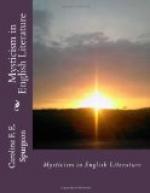Enough has been said to show that Rolle is a remarkable individual, and one of the most poetic of the English religious mystical writers, and it is regrettable that some of his other works are not more easily accessible. Unfortunately, the poem with which his name is generally associated, The Pricke of Conscience, is entirely unlike all his other work, both in form and matter. It is a long, prosaic and entirely unmystical homily in riming couplets, of a very ordinary mediaeval type, stirring men’s minds to the horrors of sin by dwelling on the pains of purgatory and hell. It would seem almost certain, on internal evidence, that the same hand cannot have written it and the Fire of Love, and recent investigation appears to make it clear that Rolle’s part in it, if any, was merely of the nature of compilation or translation of some other work, possibly by Grosseteste.[63]
Of the life of the Lady Julian we know very little, except that she was almost certainly a Benedictine nun, and that she lived for many years in an anchoress’s cell close to the old church of St Julian at Conisford, near Norwich. But her character and charm are fully revealed in the little book she has left of Revelations of Divine Love, which contains a careful account of a definite psychological experience through which she passed on the 8th day of May 1373, when she was thirty years of age. She adds to this record of fact certain commentaries and explanations which, she says, have been taught her gradually in the course of the subsequent twenty years. This experience, which lasted altogether between five and six hours, was preceded by a seven days’ sickness most vividly described, ending in a semi-rigidity of the body as if it were already half dead, and it took the form of sixteen “Shewings” or “Visions.” These, she says, reached her in three ways, “by bodily sight, by word formed in mine understanding” (verbal messages which took form in her mind), “and by spiritual sight.” But of this last, she adds, “I may never fully tell it."[64] It is impossible here to do justice to this little book, for it is one of the most important documents in the history of mysticism.




